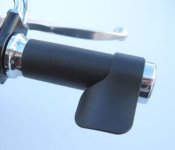Anthony King
100 mW
After doing a couple of short shakedown rides I took the half-fat e-dummy on a couple long, hilly rides today.
I was very curious how much juice it would take to get both kids back from my sister in law's, a 17 mile route with 1,134 ft. of elevation gain. The battery (36V 20Ah Ping) went through 18.46Ah and the voltage at the end of the ride was 39.7. I pedaled quite a bit, but didn't kill myself.
Here are the happy passengers:

I'm fairly satisfied so far. Since it appears the bike will make bicycle errand trips with the kids in town possible (12 miles, relatively flat but one big hill coming home) it would be nice if the whole family could come. So I'd like build a bike for my wife.
I think the eZee I currently have on the Big Dummy would work well for her. So I could either get another for her or . . .
I could give her mine if it makes sense to upgrade the motor on the Big Dummy.
The eZee worked pretty well, but with the kids on the bike and no other cargo the motor seemed to bog down when the grades got over 4%. I'd like to be able to carry the kids and extra cargo when running errands and get up the big hill coming back home a little easier.
Any general advice welcomed, but I have a few specific questions.
1) What difference can I expect if I reduce the wheel size on the cargo bike? I have used 24" wheels on it in the past and could significantly reduce the diameter of the front wheel (18% redcution) by going with a 24 inch rim and more modest tire. The ultra-fat front tire does make for a smooth ride, but if climbing will be significantly improved by reducing the diameter I'll relace the wheel and give it a go.
2) Since in use the bike is very heavy and speed isn't much of a concern would a powerful direct drive motor make any sense since I could extend the battery with regen in hilly New England?
3) If so, what DD motors should I look at recommend?
4) Am I correctly diagnosing the "boggy" or "jerky-jerky" motor sensation on the steepest sections of road as lack of motor power? On these sections I seemed to be able to back off the throttle a little and find a sweet spot where the motor felt smooth.
If I should leave well enough alone and jus build my wife a bike, don't be afraid to tell me. I have a feeling I won't get that advice around here. Keep in mind speed isn't my concern. It would be nice to stay around 10mph on the steep hills (while pedalling moderately). My concern is being able to get a vehicle that could top out at over 400lbs. up hills.
Also open to cases for non-hub drivetrains if you think that would improve the bike.
Thanks as always.
I was very curious how much juice it would take to get both kids back from my sister in law's, a 17 mile route with 1,134 ft. of elevation gain. The battery (36V 20Ah Ping) went through 18.46Ah and the voltage at the end of the ride was 39.7. I pedaled quite a bit, but didn't kill myself.
Here are the happy passengers:

I'm fairly satisfied so far. Since it appears the bike will make bicycle errand trips with the kids in town possible (12 miles, relatively flat but one big hill coming home) it would be nice if the whole family could come. So I'd like build a bike for my wife.
I think the eZee I currently have on the Big Dummy would work well for her. So I could either get another for her or . . .
I could give her mine if it makes sense to upgrade the motor on the Big Dummy.
The eZee worked pretty well, but with the kids on the bike and no other cargo the motor seemed to bog down when the grades got over 4%. I'd like to be able to carry the kids and extra cargo when running errands and get up the big hill coming back home a little easier.
Any general advice welcomed, but I have a few specific questions.
1) What difference can I expect if I reduce the wheel size on the cargo bike? I have used 24" wheels on it in the past and could significantly reduce the diameter of the front wheel (18% redcution) by going with a 24 inch rim and more modest tire. The ultra-fat front tire does make for a smooth ride, but if climbing will be significantly improved by reducing the diameter I'll relace the wheel and give it a go.
2) Since in use the bike is very heavy and speed isn't much of a concern would a powerful direct drive motor make any sense since I could extend the battery with regen in hilly New England?
3) If so, what DD motors should I look at recommend?
4) Am I correctly diagnosing the "boggy" or "jerky-jerky" motor sensation on the steepest sections of road as lack of motor power? On these sections I seemed to be able to back off the throttle a little and find a sweet spot where the motor felt smooth.
If I should leave well enough alone and jus build my wife a bike, don't be afraid to tell me. I have a feeling I won't get that advice around here. Keep in mind speed isn't my concern. It would be nice to stay around 10mph on the steep hills (while pedalling moderately). My concern is being able to get a vehicle that could top out at over 400lbs. up hills.
Also open to cases for non-hub drivetrains if you think that would improve the bike.
Thanks as always.



